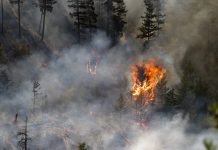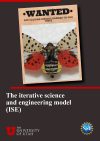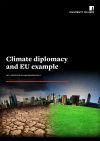The Intergovernmental Panel for Climate Change (IPCC) identifies climate change as one of the most serious global challenges to ecosystems and societies. A crucial feature is the rise in mean ambient temperature. Models predict that in the next few decades temperatures could increase by 2-4ºC, exceeding what most forest ecosystems would be able to handle. IPCC and the International Union of Forest Research Organizations (IUFRO) project that as a result forest distribution and species composition will drastically change. This is a worrying prospect, as the importance of forests can hardly be overestimated. In North-Europe, forests cover as much as 55-75% of the land, 50% of which is coniferous, 25% is broad-leaved, and 25% mixed. These forests are not only reservoirs of biodiversity, providing crucial wildlife habitats, they also represent substantial economic value, and provide societal, health and recreational benefits. Moreover, they mitigate climate change by storing carbon dioxide and holding water.
Warming affects forests
Elevated levels of carbon dioxide, a significant driver of temperature increase, might initially benefit temperate and boreal forests, but eventually alter their geographical location and compromise species diversity. Projections indicate that temperate forests will migrate northwards and invade the boreal zone, thereby reducing the competitiveness of boreal species. Because climate change will outpace the natural migration rate of many tree species, the more aggressive, adaptable and fast-growing species will become dominant in the newly established areas.
Instability reduces tree survival
Global warming will not only raise the mean annual temperature but also give rise to weather instability, characterised by unusual fluctuations in humidity and temperature. Some areas will become drier and hotter, resulting in draughts, while other areas will experience increased precipitation and waterlogging. The frequency of storms and pest outbreaks will increase, resulting in die-off and decay of many trees. Although currently temperate forests are carbon sinks, increased migration-related forest destruction and warming-induced conversion of organic soil matter could turn forests into carbon dioxide sources. A different and potentially serious effect of weather instabilities is that they compromise the ancient and fine-tuned interplay of trees with the environment to which they are adapted. Fine-tuning is crucial for survival, as it allows trees to maximise their short growth period as well as timely preparation for winter. That climate change might compromise this fine-tuned relationship has received little attention in climate models. Our investigations focus on how photoperiod- and temperature-driven signalling events schedule growth and survival strategies. Understanding how trees regulate their seasonal cycle in response to a changing environment will help to prognosis and mitigate the effects of climate change.
Seeing light and sensing cold
Deciduous trees use their responsiveness to the day-night cycle to foretell the arrival of winter. They utilise photosensitive pigments in their leaves that give input to a genetically controlled clock. When a critical shortening of the light period is registered, the clock sends a signal to the growing points to trigger preparations for winter. Each local tree population (ecotype) has its own ‘day length set value’ at which it responds, giving it just enough time to prepare for winter in their local environment. When the signal arrives, the growing point ceases apical elongation and switches from leaf to bud scale production. Inside the bud, a dwarfed shoot system emerges that arrests growth and establishes dormancy when the bud is completed. Essentially, the bud is a survival package that allows a rapid start in spring. Winter buds are crucial to survival and longevity, and without them, temperate and boreal forests would not exist. Dormancy not only arrests growth, but it also primes the bud for freezing-tolerance to protect cells during winter. Our work established that growth arrest is governed by genes that block communication between cells in the growing point, transforming a functionally integrated cell society into a collection of isolated individuals. At the same time, other genes are expressed that direct cellular physiology towards a freezing tolerant state. The chill of the approaching winter has 2 effects: it breaks dormancy by re-opening the communication channels and reversing the capacity of cells for networking, and it further deepens tolerance to freezing. The result is that the arrested system is now highly freezing tolerant, but poised for rapid growth once temperatures rise in spring. Thus, interestingly, Northern trees have turned the pre-winter chill from foe to friend.
Compromised fine-tuning
The mechanisms that fine-tune the growth and survival strategies function well in the stable climate in which trees evolved. However, the unusual weather fluctuations projected by climate change models may seriously compromise the environmental scheduling of these strategies. Longer warm spells in mid-winter can awake non-dormant buds and remove freezing-tolerance, thus leaving them unprotected from returning frost. This could result in considerable damage to both wild and domesticated tree species. We therefore urgently need to improve our understanding of the survival strategies forest trees rely on, the degree of resilience they confer, and if they can be modified to better fit changing conditions. It requires coordinated efforts of cross-disciplinary teams to integrate knowledge – from genes to cells, trees and forest ecosystems. Presently, we know too little of how individual forest trees will cope under a changing climate, and how their distribution and survival will be affected. Fortunately, there is a growing awareness among policymakers, the public, forest owners and forest-based industries of the urgency of these problems. Norway actively supports forest research, but to obtain an integrated view of climate change impact we urgently need to strengthen investigations that elucidate the genetic and cellular mechanisms that trees use to fine-tune their relation to the environment.
Dr Christiaan van der Schoot
Professor
Tel: +47 6723 2805
Dr Päivi LH Rinne
Research-Professor
Tel: +47 6723 2804
paivi.rinne@nmbu.no
Norwegian University of Life Sciences

























